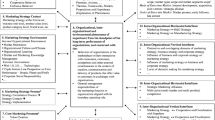Abstract
Since at least the late 1950s, it has been recognized that multinational enterprises operate in imperfect markets characterized by oligopoly. The dominant “transactions-cost” theory of multinational enterprises does not wholly account for why this is so. The reductio ad absurdum of this theory would predict imperfect markets to be sure, but they would be monopolistic rather than oligopolistic. In this article, a simple model based on noncooperative game theory shows how oligopolistic markets can evolve from monopolistic ones. Also shown is that it is neither necessary nor sufficient that a firm have lower costs than its rivals in order to have an incentive to become multinational.
Similar content being viewed by others
Author information
Authors and Affiliations
Additional information
Copyright © 1998 Institute for International Economics.
*Senior Fellow, Institute for International Economics.
Rights and permissions
About this article
Cite this article
Graham, E. Market Structure and the Multinational Enterprise: A Game-theoretic Approach. J Int Bus Stud 29, 67–83 (1998). https://doi.org/10.1057/palgrave.jibs.8490025
Published:
Issue Date:
DOI: https://doi.org/10.1057/palgrave.jibs.8490025




